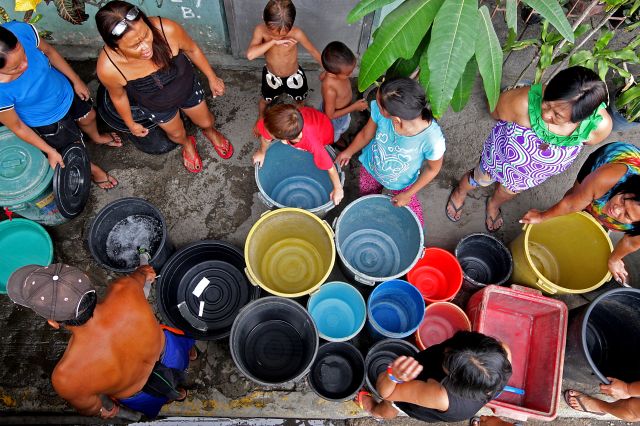
Barangay Tinago, Cebu City residents ready their water containers as they wait for the city government’s fire trucks to supply them water in this file photo.
Expert cites causes of water resources’ depletion, calls for urgent need to address problem
With the depletion over time of the water supply in the province of Cebu caused by several factors, a water resources expert is encouraging the government to implement several good policies and laws meant to address issues involving its water resources.
Engineer Fe Walag, executive director of the University of San Carlos-Water Resources Center (USC-WRC), cited the Clean Water Act, Clean Air Act, Water Quality Management Act, and Ecological Solid Waste Management Act, as among the laws that needed to be properly implemented.
“There is a need to review existing laws to identify what we need or what is lacking. We need to come up (with) an enhanced version of these laws to face the present problem, and then come up with a mechanism to implement these laws,” said Walag.
Walag cited rapid population growth, economic development, urbanization and poor management of water resources as among the factors that led to the depletion over time of water supply in Cebu.
She said ground and surface water sources in the province have become at risk to pollution and reduction due to abuse while infrastructure developments have lessened the ability of natural aquifers below the ground to recharge its supply.
AQUIFERS
“If you cover the aquifers, which is the limestone, (by constructing buildings), in effect, you are reducing the recharge to your aquifer,” she told Cebu Daily News in an interview.
Aquifers, she explained, are geologic formations that can “accept, store, and release water” which mostly comes from rain.
Walag said that infrastructure projects have “covered” these naturally existing aquifers, resulting to a lower water table.
A lower water table, she added, encourages people to pump more.
Overpumping, she emphasized, has led to even bigger problems such as salt water intrusion and pollution.
She said that since the density of saltwater is higher than freshwater, it has a tendency to intrude when the latter is pumped.
Based on monitoring done by the USC-WRC, saltwater has now gone quite far inland, and it is showing no signs of stopping.
Walag added that it should slow down, but she is uncertain for how long.
“That is the result of unsustainable water extraction,” she added.
The director said that there are also no regulations in effect that limit how deep into the ground individuals can go to extract water, and, although, there is an existing national law, it is not site specific.
“The problem with that is there are no researches downscaling existing values. They have values in Luzon, and they want to bring it here, but we have different aquifers on the island. Because of a lack of regulations, we have been unable to control the pumping of groundwater,” she said.
WATER SOURCES
Cebu gets its main source of water from the rain, accumulating 1,600 mm of rainfall in the coastal areas and more than 1,700 mm in upland areas.
Part of rainwater becomes flood or surface run-off while a smaller portion of it goes into the soil and eventually becomes groundwater.
However big, a bigger portion of this is lost to evapo-transpiration, Walag said, leaving only roughly 500 to 600 mm as groundwater supply.
According to state weather bureau, Philippine Atmospheric Geophysical and Astronomical Services Administration (Pagasa), one mm of rain per hour is approximately 5,000 drums of water or 1.04 million liters per hour per square kilometer.
“Since the development of Cebu, people have been relying on groundwater sources,” said Walag.
SURFACE WATER
She, however, said that there are also surface water sources in the province.
Surface water sources, Walag cited, include the Buhisan Dam in Cebu City, the Malubog Dam in Toledo City, the Jaclupan Dam in Talisay City, and smaller weirs all over the province used for irrigation of agricultural lands.
Walag said that while water resources in Cebu have greatly been affected by the drought, they expect these to recover due to the rainy season.
With these water supply problems, the Cebu provincial government has also initiated moves to create a water management plan.
WATER PLAN
Last April 2016, the Cebu Provincial Water Resources Authority (CPWRA) held its first meeting to discuss plans for this Cebu Water Management Plan.
Engineer Edgar Sibonga, CPWRA executive director, said the management body will formulate a Water Code to regulate, allocate and utilize water resources in the province of Cebu.
Cebu’s Water Code will be patterned on the Water Code of the Philippines and successful water resources organizations in California and Singapore, Sibonga said.
The creation of the organization will help lessen the province’s dependence on the Manila-based National Water Resources Board.
Cebu Gov. Hilario Davide III issued an executive order laying down the management body’s composition in March this year.
This was in line with the provincial government’s efforts to address water-related problems brought about by the El Niño.